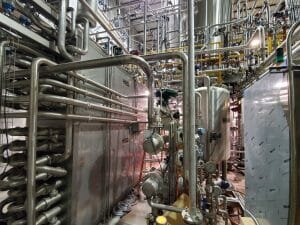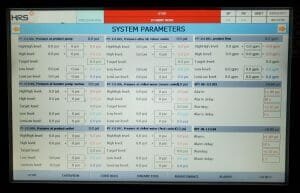Normally the supply, installation and commissioning of a heat exchanger to sterilise food ingredients such as wort would be a relatively straightforward exercise, with HRS project engineers travelling from their bases in Spain or the UK to the client’s location. However, the travel and operation restrictions imposed globally by the Coronavirus pandemic earlier this year meant that a different approach was required for one HRS MI Series installation in the United States in April and May of 2020.
Based in the United States, the client manufactures natural food ingredients, such as yeast extracts, derivatives and natural flavourings for use by other food producers. It is important that the fermenters are sterilised in order to maintain hygiene and the new system allows the client to create a sterile fermentation media for growing its cultures as well as pasteurising its finished product to ensure it is safe.
The solution was an Aseptic UHT system based on an HRS Aseptic Block comprising a balance tank for the incoming wort, a Steriliser based on the MI Series of hygienic multitube heat exchangers with heat recovery, a water heating system based on an HRS K Series multitube heat exchanger and associated pumps and control system.
The hygienic stainless-steel system raises the temperature of the wort from 30°C to 140°C for sterilisation, before cooling it back down to 40°C, and is capable of treating up to 10,000 kg of product every hour. A heat recovery system is included in the design to improve overall energy efficiency be using some of the heat from the cooling water to help heat the product entering the system.
The Aseptic Block system was delivered in late summer 2019 and installed by the client. At this point HRS project engineers would normally visit the client to complete the commissioning and troubleshooting process. However, by March 2020, the world was a very different place due to the Coronavirus pandemic. Spain was in lockdown and there were travel restrictions between many parts of Europe and the United States.
It was therefore necessary to come up with a different method for commissioning the system. All HRS systems can, with the customer’s agreement, be fitted with a remote monitoring and telemetry system using either an ethernet connection (as is the case with this project) or an integrated data SIM in the equipment.
This enabled a dedicated project engineer, to manage the commissioning from Murcia in Spain along with a system programmer. To allow for the six-hour time difference with US Eastern Time, the HRS team worked at night, resulting in minimal disruption to the client’s day-to-day business and allowing the remote team to address issues as they were identified. This allowed the system software to be adjusted as necessary while the steriliser was operating. Backed up by regular dialogue using online conferencing software, the set-up and commissioning process was completed in just four weeks.
The client commented: “The HRS team was really helpful, and it was a pleasure to work with the project engineer and programmers who were very quick to resolve any problems that occurred. Despite the time difference the team was always willing to work around our schedule and despite some difficulties it was a relatively painless experience considering the thousands of miles separating us.”
The new UHT system allows the client to pasteurise its growing media and finished products faster and in a more energy-efficient manner. It has also improved product quality by browning and negative flavour impacts which had previously been associated with prolonged exposure to high temperatures under the old pasteurization regime.
HRS Sales & Marketing Director Matt Hale comments: “Although perhaps not ideal from an engineering point of view, this installation shows what is technically possible using our existing equipment and remote access. It reduced the time spent commission compared to our normal approach, and reduced international travel also reduced our carbon footprint. As we continue to adapt to working in a post-COVID world, it is good to know that we have the technology and systems to allow us to work remotely with clients around the world.”
- The system was installed by the client’s engineers and commissioned remotely by HRS from their Spanish factory
- The ethernet connection means that all the system programs and operating parameters can be controlled remotely by HRS in Spain







